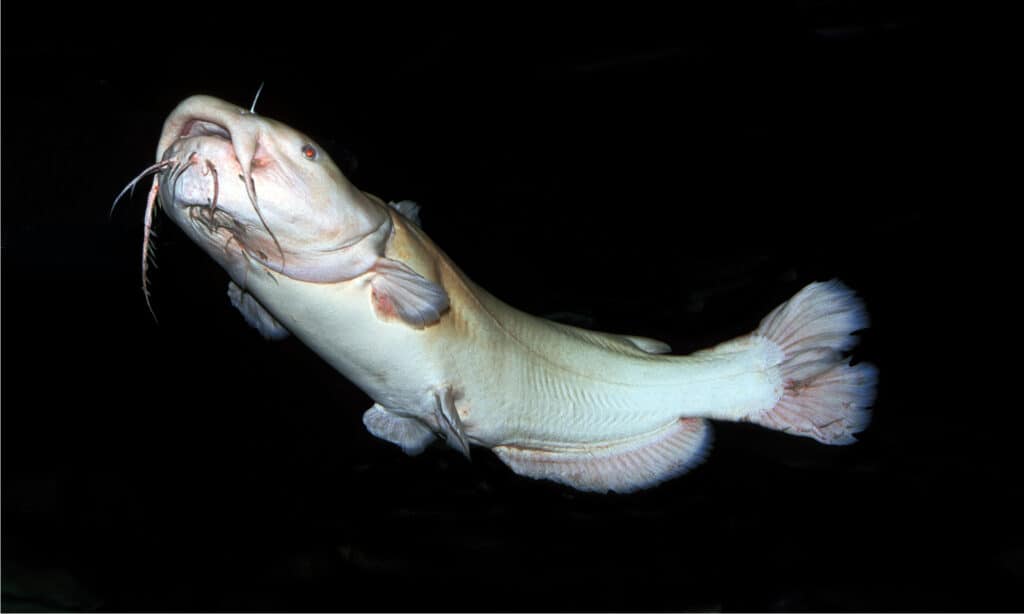Flathead Catfish
Pylodictis olivaris
The only predators that prey on flathead catfish are members of their own species and humans who catch them for commercial and recreational purposes.
Advertisement
Flathead Catfish Scientific Classification
- Kingdom
- Animalia
- Phylum
- Chordata
- Class
- Actinopterygii
- Order
- Siluriformes
- Family
- Ictaluridae
- Genus
- Pylodictis
- Scientific Name
- Pylodictis olivaris
Read our Complete Guide to Classification of Animals.
Flathead Catfish Conservation Status
Flathead Catfish Facts
- Name Of Young
- Fry
- Group Behavior
- Solitary
- Fun Fact
- The only predators that prey on flathead catfish are members of their own species and humans who catch them for commercial and recreational purposes.
- Most Distinctive Feature
- Flat head
- Average Spawn Size
- 100 000
Flathead Catfish Physical Characteristics
- Color
- Brown
- Yellow
- White
View all of the Flathead Catfish images!
The flathead catfish is a large common species that is definitely not known for its looks. They are freshwater catfish, and fishermen often hook large specimens that put up a tough fight.
These catfish play a role in commercial and recreational use and can be a decent meal if fished from a clean environment.
Flathead catfish inhabit many regions where they occur naturally or from transplanting and can grow relatively quickly. Their size ranges from 10 to 15 pounds, but it’s not uncommon for fishermen to catch specimens up to 20 pounds. However, in pristine waters, there is a possibility of catching a flathead catfish weighing over 50 pounds.
Three Amazing Flathead Catfish Facts
- Flatheads are solitary fish, making it impossible to breed them in captivity; however, they can mate in large ponds. They spawn when the water temperature starts to rise, which is usually late spring.
- Most catfish are scavengers, but flatheads are not; they only prey on live fish. Juveniles mainly eat invertebrates like insects, worms, and crayfish
- In Texas, flathead catfish are the second largest sport fish; the biggest is the blue catfish
Different Types of Catfish
There are over 3000 catfish species, making up 40 types of families, of which 30 are native to the USA! The three main species are blue catfish, channel catfish, and flathead catfish.
Blue Catfish
Blue catfish live up to their name with their light and dark blue coloring that sometimes appears black. They have a white underbelly and no spots. Their average weight is between 20 to 40 pounds.
Channel Catfish
Channel catfish are typically olive-brown to gray and have dark spots covering their bodies, particularly in smaller fish. In addition, they have a whitish-silver underbelly and can weigh around 30 pounds.
Wels Catfish
Wels catfish are the only catfish species native to Europe and inhabit the Black, Baltic and Caspian seas. They are gigantic and may measure up to 6 feet long, and can weigh up to 143 pounds!
Flathead Catfish Scientific Name
The flathead catfish’s scientific name is Pylodictis olivaris, and it belongs to the Order Siluriformes. They occur inland or in coastal waters on every continent except Antarctica. However, they have inhabited every continent at some point.
Siluriformes are most diverse in tropical regions like Asia, South America, and Africa. But one family occurs in Europe and another in North America.
The Americas are home to more than half of the species, and only freshwater species inhabit Madagascar, South Africa, Australia, and New Guinea.
Flathead catfish are members of the Family Ictaluridae, which includes 49 species. They are the largest family of freshwater fishes native to North America.
They are easily recognized compared to other North American freshwater fishes. Their two most significant identifying features are 4 pairs of whiskers (barbels) around the mouth and no scales.
Unlike other large groups of North American freshwater fishes like darters, minnows, and suckers, who are diurnal, members of the family Ictaliuridae are mainly nocturnal.
Flathead Catfish Appearance

Flathead Catfish tails are squared and forked.
©slowmotiongli/Shutterstock.com
It is not hard to distinguish a flathead catfish from other species. Their tails are squared and forked, and they have large flattened heads with long bodies. Medium to large specimens often have pot-bellies, beady eyes, and broad heads.
Their eyes highlight the flatness of their heads, which are distinctly flat and in the shape of an oval. In addition, their lower jaw also draws attention to their heads because it protrudes beyond the upper jaw. Finally, unlike other catfish species, the flathead’s anal fin is short, with only 14 to 17 fin rays.
The flathead catfish’s color differs depending on their environment, but they are primarily mottled with varying shades of brown and yellow sides, and their bellies are mottled white.
In addition, flathead catfishes have sharp, heavy dorsal and pectoral spines and long whiskers next to their mouths.
They can grow to lengths of 61 inches and top the scales at a whopping 123 pounds, which makes them the second largest North American catfish after the blue catfish (Ictalurus furcatus). However, their average length is around 25 to 46 inches.
Flathead Catfish Behavior
The flathead catfish prefer the deeper parts of lakes and rivers. They ambush their prey, waiting under cover until their prey comes closer. Flatheads are nocturnal; however, they are also sometimes active during the day.
In addition, they are primarily piscivorous, meaning their diet consists mainly of fish, and they are known for eating other game fish in areas where they are an invasive species. However, when the water temperature drops below 50°F, they become inactive.
Flathead Catfish Habitat
Flathead catfish occur mainly in large bodies of water like big rivers and reservoirs. They prefer deep pools in rivers where there is calm water flow. In addition, they like depressions or holes that exist in eddies and adjacent to bridge pilings.
Another popular habitat is tailraces below dams. Their ideal hiding spot often has a hard bottom and possibly has timber or driftwood in it.
However, in large reservoirs, flathead catfish mainly occur in deeper areas, usually in old river beds and near the headwater tributary.
Flathead Catfish Diet
Flathead catfish are omnivores and opportunistic hunters, and they eat a variety of food available to them. They are mainly bottom feeders and prey on animals like:
In addition, they feed on terrestrial animals that dare to come too close to the water. The best bait to use when trying to catch a flathead catfish is live fish, more so than other catfish species. Surprisingly, they seem to be deterred by old, sticky bait.
While these fish are active during the day, they are primarily nocturnal and spend their days inactive in the deep water, hidden under cover. Then, as it starts to get dark, they migrate to shallow water to feed.
Flathead Catfish Predators and Threats
The only predators that prey on flathead catfish are members of their own species and humans who catch them for commercial and recreational purposes.
However, larvae and juveniles are susceptible to attacks from wading birds like herons and other birds of prey that inhabit the forage in streams and rivers.
Flathead catfish have no known threats. Their population is stable at the moment, but pollution and sport fishing could lead to a decline in numbers.
No conservation efforts are in place to protect the flathead catfish, and they are listed as a Least Concern on IUCN’s Redlist.
Flathead Catfish Reproduction, Babies, and Lifespan
| Breeding Interval | Breed once a year |
| Breeding Season | Between June and July |
| Number of Offspring | 100,000 |
| Time to Hatching | 6 to 9 days |
| Sexually Mature (female) | 3 to 5 years |
| Sexually Mature (male) | 3 to 7 years |
While the flathead catfishes’ mating systems have not been documented in the wild, scientists have observed them in captivity. During reproduction, the male will move over and around the female while rubbing her with his belly and barbels (whiskers).
Next, the males stop swimming with their tails surrounding the female’s head and start to convulse. They repeat this behavior frequently until the female begins to spawn, which takes around 14 days.
When captive females spawned, they deposited their eggs in a depression that the aquarium made in the gravel. Lastly, the eggs were fertilized by the males.
Spawning takes approximately 4 hours, and males become incredibly aggressive and start defending the eggs, even from the females who laid them.
Flathead Catfish Mating System
Flathead catfish are monogamous, and their sexual maturity depends on their environment. However, it usually ranges from 3 to 7 years in females and 3 to 5 years in males.
Females spawn during the summer when the water temperature rises between 75.2°F to 84.2°F. Their eggs start to hatch between 6 to 9 days after fertilization.
Flathead catfish construct nests under cover, which include brush piles, stumps, rock outcroppings, and logs. The number of eggs females lay depends on their body size, but a single nest can host up to 100,000 eggs. The eggs stick together in clusters and are expelled in masses of 30 to 50 eggs.
Main Reproductive Features
- Iteroparous
- Seasonal Breeding
- Separate sexes
- Sexual fertilization
- Oviparous
The males take over responsibility once the eggs hatch and will continue to watch over the newborn fish for a few days.
Lifespan/Longevity
The flathead catfish has an average lifespan of 5 to 22 years. However, they can live up to 28 years. Scientist can tell their age from their pectoral spine and otolith age estimates. Because these catfish are so large, they are not often kept in captivity.
Flathead Catfish Population
Because this species has large numbers of subpopulations in various locations, it is hard to determine the total population size.
However, IUCN’s Redlist listed them as Least Concern with a stable population. But, due to severe pollution, it is likely that their numbers have slowly declined over the last ten years.
Communication
Their spawning activities indicate that the flathead catfish use tactile and chemical cues to communicate.
These cunning fish can sense their environment by using their mechanosensory lateral line, eyes, and barbels. In addition, flathead catfish have a great sense of hearing due to their Weberian apparatus that connects the inner ear to the swim bladder (severs as a resonance chamber).
Ecosystem Roles
The flathead catfish are one of the main predators of other fish species in their habitats and can be invasive in areas where they do not naturally occur. In addition, they play host to over 25 different parasitic species, including:
- Nematodes
- Leeches
- Platyhelminth worms
- Copepods
- Fresh mussel larvae
- Water lice
Angling
Flathead catfish are a sought-after catch for anglers in lakes and rivers. In addition, they provide a tough fight, which makes all the effort worth it. Larger specimens are often found in snag-filled environs and can take a while to subdue. Heavy tackle is needed to catch one of these beasts and live fish as bait.
Impacts
When the flathead catfish were introduced into new states, researchers saw a massive decline in native fish populations, making them a threat to biodiversity.
For example, when they were introduced to the Altamaha River in Georgia, they decimated the bullhead catfish population, and researchers saw an 80% reduction in the number of redbreast sunfish.
In addition, flatheads have eliminated native catfish numbers in the coastal North Carolina rivers and still prey on shad and crayfish as well. They also threaten crabs and American eels who share their habitat.
Economic Costs
Some findings suggest that flathead catfish predation may obstruct restoration efforts of sturgeon, shad, American eel, and striped bass in the Delaware Estuary.
Health Risks
Eating a flathead catfish could be risky because they are susceptible to contaminants like polychlorinated biphenyls, which cause rashes, and is poisonous.
This is why the Commonwealth of Pennsylvania advises that eating flatheads caught in the lower Schuylkill river should be limited to once a month. However, more testing is required to determine how safe eating flatheads from other environments is.
Prevention and Control
Researchers believe that electrofishing and intense sport fishing may help diminish flathead populations in areas where they do not naturally occur, so native fish species can survive. In Delaware and Susquehanna, anglers are asked not to release them when caught, no matter their size.
Flathead Catfish in Aquariums
It is tough keeping a flathead catfish in captivity; however, it is not impossible. They need a large enough aquarium with many hiding places, which you can provide with a few stones, large roots, and bogwood.
Flatheads grow quickly, so you must consider that when choosing the size of your aquarium. Unless your aquarium is extremely large, only one adult male should exist. In addition, their tankmates need to be big enough so that the flatheads’ can’t eat them.
Because flatheads eat a lot, the aquarium must be well filtered; otherwise, it puts a lot of stress on the water quality. In addition, the pH level in the tank must be 6-8, and the temperature around 77-82°F.
Like many other catfish species in captivity, flatheads eat almost anything and are very easy to feed. They will accept various dead food (even without training), but their primary diet in the wild is catfish and other small fish species. In addition, they also prey on terrestrial animals like young birds, frogs, and crayfish.
Breeding flathead catfish in captivity is close to impossible because of their solitary nature, but they do breed in large ponds.
In their natural habitats, flathead catfish spawn towards the end of spring when the water temperature starts to rise.
View all 91 animals that start with FFlathead Catfish FAQs (Frequently Asked Questions)
What is the average lifespan of a flathead catfish?
Flathead catfish can live for 5 to 22 years on average.
What is best bait for flathead catfish?
Flathead catfish are best caught with live bait like small fish.
Do catfish eat their babies?
No, catfish do not eat their own young but will prey on the young of other fish species.
What is catfish favorite food?
Their favorite food is small fish.
Thank you for reading! Have some feedback for us? Contact the AZ Animals editorial team.
Sources
- Live About / Accessed August 23, 2022
- Aquatic Community / Accessed August 23, 2022
- Wikipedia / Accessed August 23, 2022
- Texas Parks and Wildlife / Accessed August 23, 2022
- Chesapeake Bay Program / Accessed August 23, 2022
- Missouri Department of Conservation / Accessed August 23, 2022
- IUCN Redlist / Accessed August 23, 2022


















